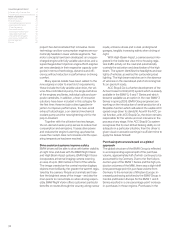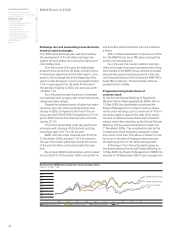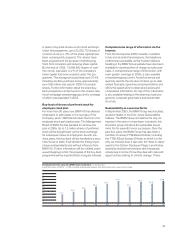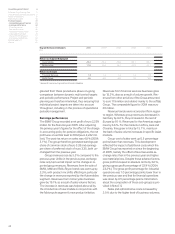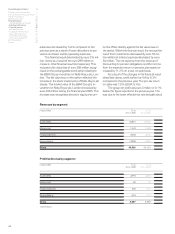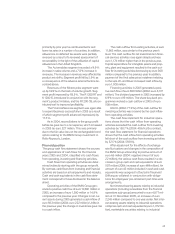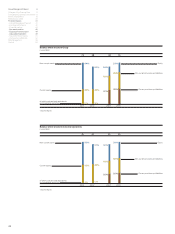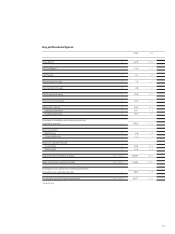BMW 2005 Annual Report Download - page 43
Download and view the complete annual report
Please find page 43 of the 2005 BMW annual report below. You can navigate through the pages in the report by either clicking on the pages listed below, or by using the keyword search tool below to find specific information within the annual report.
42
gleaned from these procedures allows on-going
comparison between dynamic multi-period targets
and periodic performance. Project and periodic
planning are therefore interlinked, thus ensuring that
individual project targets are taken into account
throughout, including in the process of operational
periodic management.
Earnings performance
The BMW Group recorded a net profit of euro 2,239
million for the financial year 2005. After adjusting
the previous year’s figures for the effect of the change
in accounting policy for pension obligations, the net
profit was at a similar level to 2004 (euro 2,242 mil-
lion). The post-tax return on sales was 4.8 % (2004:
5.1%). The group therefore generated earnings per
share of common stock of euro 3.33 and earnings
per share of preferred stock of euro 3.35, both un-
changed from the previous year.
Group revenues rose by 5.2% compared to the
previous year. Unlike in the previous year, exchange
rates only had a small impact on the change in re-
ported group revenues. Revenues from the sale of
BMW, MINI and Rolls-Royce brand cars went up by
2.3%, with product mix shifts affecting in particular
the change in revenues reported by the Automobiles
segment. Revenues from motorcycles business
grew by 19.1% as a result of sales volume factors.
The increase in revenues was helped above all by
the introduction of new models in conjunction with
the Motorcycle segment’s new product initiative.
Revenues from financial services business grew
by 18.2%, also as a result of volume growth. Rev-
enues from other activities of the Group amounted
to euro 119 million and related mainly to the softlab
Group. The comparable figure for 2004 was euro
85 million.
Revenue trends were inconsistent from region
to region. Whereas group revenues decreased in
Germany by 8.0 %, they increased in the rest of
Europe by 9.1%. Revenues for the Americas region
rose by 8.6%. For the markets in Africa, Asia and
Oceania, they grew in total by 15.7%, mainly on
the back of sales volume increases in specific Asian
markets.
Group cost of sales went up 0.5 percentage
points faster than revenues. This development
reflected the impact of additional costs which the
BMW Group has reported on since the beginning
of 2005, namely the effect of less favourable ex-
change rates than in the previous year and higher
raw material prices. Despite these adverse factors,
gross profit increased in absolute terms by 3.6%,
giving a gross profit percentage of 22.9% (2004:
23.2%). The gross profit percentage for industrial
operations was 1.0 percentage points lower than in
the previous year and that for financial operations
was down by 0.5 percentage points. Information
about the composition of these sub-groups is pro-
vided in Note [1].
Sales and administrative costs increased by
2.5% due to the higher level of business volumes;
Group Management Report 8
A Review of the Financial Year 8
The General Economic Environment 11
Review of operations 15
BMW Stock in 2005 38
Financial Analysis 41
--Internal Management System 41
--Earnings performance 42
--Financial position 45
--Net assets position 46
--Subsequent events report 49
--Value added statement 49
--Key performance figures 51
--Comments on BMW AG 52
Risk Management 56
Outlook 60
Key performance indicators 2005 2004* 2003 2002 2001
in %
Return on Capital Employed
Automobiles 23.2 25.4 23.8 30.1 32.7
Motorcycles 17.8 10.4 16.7 22.3 22.1
Return on Assets
Financial Services 1.3 1.4 1.4 1.4 1.3
BMW Group 5.6 6.5 6.6 7.6 9.0
*adjusted for new accounting treatment of pension obligations


